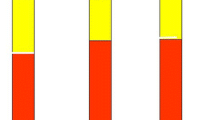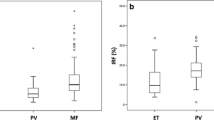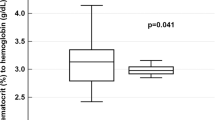Abstract
Essential thrombocythemia (ET) is a heterogeneous disorder. For example, the growth of erythropoietin-independent erythroid colonies, termed “endogenous erythroid colonies (EECs)”, has previously been observed in only 50% of ET patients. We have recently described the overexpression of a hematopoietic receptor, PRV-1 (polycythemia rubra vera-1), in patients with polycythemia vera (PV). Here, we compare PRV-1 expression and EEC formation in a cohort of 30 patients with ET; 50% of the ET patients in our cohort displayed EEC growth. Likewise, 50% of the ET patients overexpressed PRV-1. Remarkably, only the 15 ET patients displaying EEC growth showed elevated PRV-1 expression, while the 15 EEC-negative ET patients expressed normal PRV-1 levels. It has previously been reported that EEC-positive ET patients develop PV during long-term follow-up. Here, we show that 40% of the PRV-1-positive patients develop symptoms of PV during the course of their disease. In contrast, none of the 15 PRV-1-negative patients displayed such symptoms (p=0.017). Moreover, PRV-1-positive patients had a significantly higher number of thromboembolic or microcirculatory events (p=0.003). We propose that PRV-1-positive ET comprise a pathophysiologically distinct subgroup of patients, one that is at risk for the development of complications and for the emergence of PV.


Similar content being viewed by others
References
Heimpel H, Haug U, Seidler R, Anger B (1993) Chronic myeloproliferative syndromes: initial findings, evolution and prognosis in 489 cases. In: Fleischer J (ed) Leukemias. Springer, Berlin, Heidelberg, New York, pp 467–475
Jantunen R, Juvonen E, Ikkala E, Oksanen K, Anttila P, Ruutu T (1999) Development of erythrocytosis in the course of essential thrombocythemia. Ann Hematol 78:219–222
Johansson P, Andreasson B, Safai-Kutti S, Wennstrom L, Palmqvist L, Ricksten A, Lindstedt G, Kutti J (2003) The presence of a significant association between elevated PRV-1 mRNA expression and low plasma erythropoietin concentration in essential thrombocythaemia. Eur J Haematol 70:358–362
Klippel S, Strunck E, Temerinac S, Bench AJ, Meinhardt G, Mohr U, Leichtle R, Green AR, Griesshammer M, Heimpel H, Pahl HL (2003) Quantification of PRV-1 mRNA distinguishes polycythemia vera from secondary erythrocytosis. Blood 102:3569–3574
Klippel S, Strunck E, Temerinac S, Kralovics R, Prchal JT, Griesshammer M, Heimpel H, Pahl HL (2001) Quantification of PRV-1 expression, a molecular marker for the diagnosis of polycythemia vera. Blood 98:470a
Kruisbeck AM, Margulies DH, Shevach EM, Strober W (1991) Current protocols in immunology. Wiley, New York
Liu E, Jelinek J, Pastore YD, Guan YL, Prchal JF, Prchal JT (2003) Discrimination of polycythemias and thrombocytoses by novel, simple, accurate clonality assays and comparison with PRV-1 expression and BFU-E response to erythropoietin. Blood 101:3294–3301
Messinezy M, Pearson TC (1995) Incidence of myelofibrosis following treatment of primary polycythaemia by venesection. Br J Haematol 89:228–230
Murphy S, Peterson P, Iland H, Laszlo J (1997) Experience of the Polycythemia Vera Study Group with essential thrombocythemia: a final report on diagnostic criteria, survival, and leukemic transition by treatment. Semin Hematol 34:29–39
Pearson TC (1998) Diagnosis and classification of erythrocytoses and thrombocytoses. Baillieres Clin Haematol 11:695–720
Pearson TC (2002) The risk of thrombosis in essential thrombocythemia and polycythemia vera. Semin Oncol 29:16–21
Shih L-Y, Lee C-T (1994) Identification of masked polycythemia vera from patients with idiopathic marked thrombocytosis by endogenous erythroid colony assay. Blood 83:744–748
Temerinac S, Klippel S, Strunck E, Röder S, Lübbert M, Lange W, Azemar M, Meinhardt G, Schaefer HE, Pahl HL (2000) Cloning of PRV-1, a novel member of the uPAR receptor superfamily, which is overexpressed in polycythemia rubra vera. Blood 95:2569–2576
Teofili L, Martini M, Luongo M, DiMario A, Leone G, De Stefano V, Larocca L (2002) Overexpression of polycythemia rubra vera-1 gene in essential thrombocythemia. J Clin Oncol 20:4249–4254
Westwood NB, Pearson TC (1996) Diagnostic applications of haemopoietic progenitor culture techniques in polycythaemias and thrombocythaemias. Leuk Lymphoma 22:95–103
WHO (2001) Tumors of the hemopoietic and lymphoid tissues. IARC Press, Lyon
Acknowledgements
The authors sincerely appreciate Professor Dr. Geiger’s support of this work and thank H. Iwan for excellent technical assistance and C. Steimle and P. Goerttler for helpful contributions.
Author information
Authors and Affiliations
Corresponding author
Additional information
This work was supported by the Alfried Kupp Förderpreis für Junge Hochschullehrer, the Else Kröner-Fresenius-Stiftung and the SFB 364, TP A12, granted to H. L. P. as well as by the German Kompetenznetz “Acute and Chronic Leukemias” (Project 25)
Rights and permissions
About this article
Cite this article
Griesshammer, M., Klippel, S., Strunck, E. et al. PRV-1 mRNA expression discriminates two types of essential thrombocythemia. Ann Hematol 83, 364–370 (2004). https://doi.org/10.1007/s00277-004-0864-9
Received:
Accepted:
Published:
Issue Date:
DOI: https://doi.org/10.1007/s00277-004-0864-9




